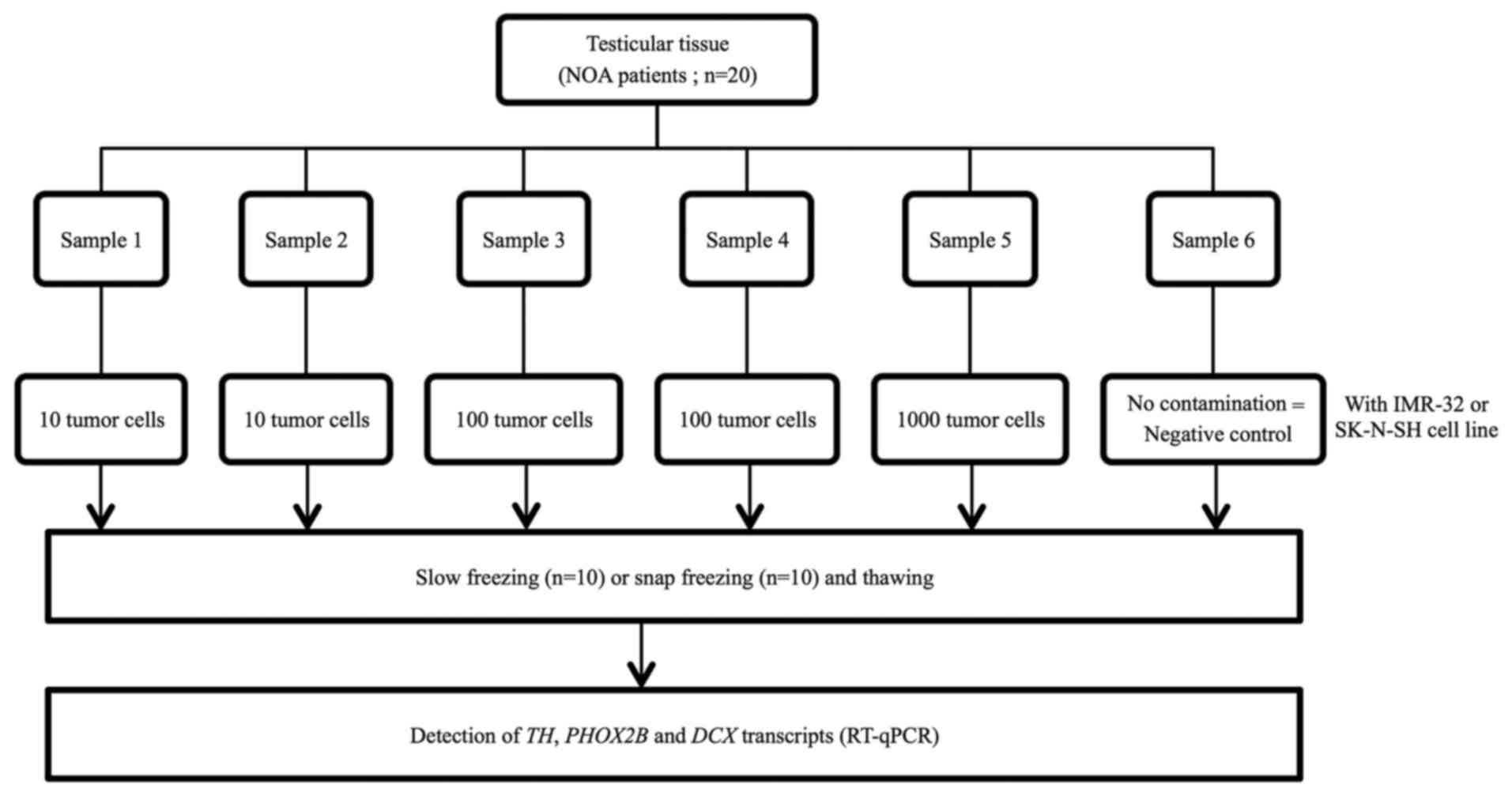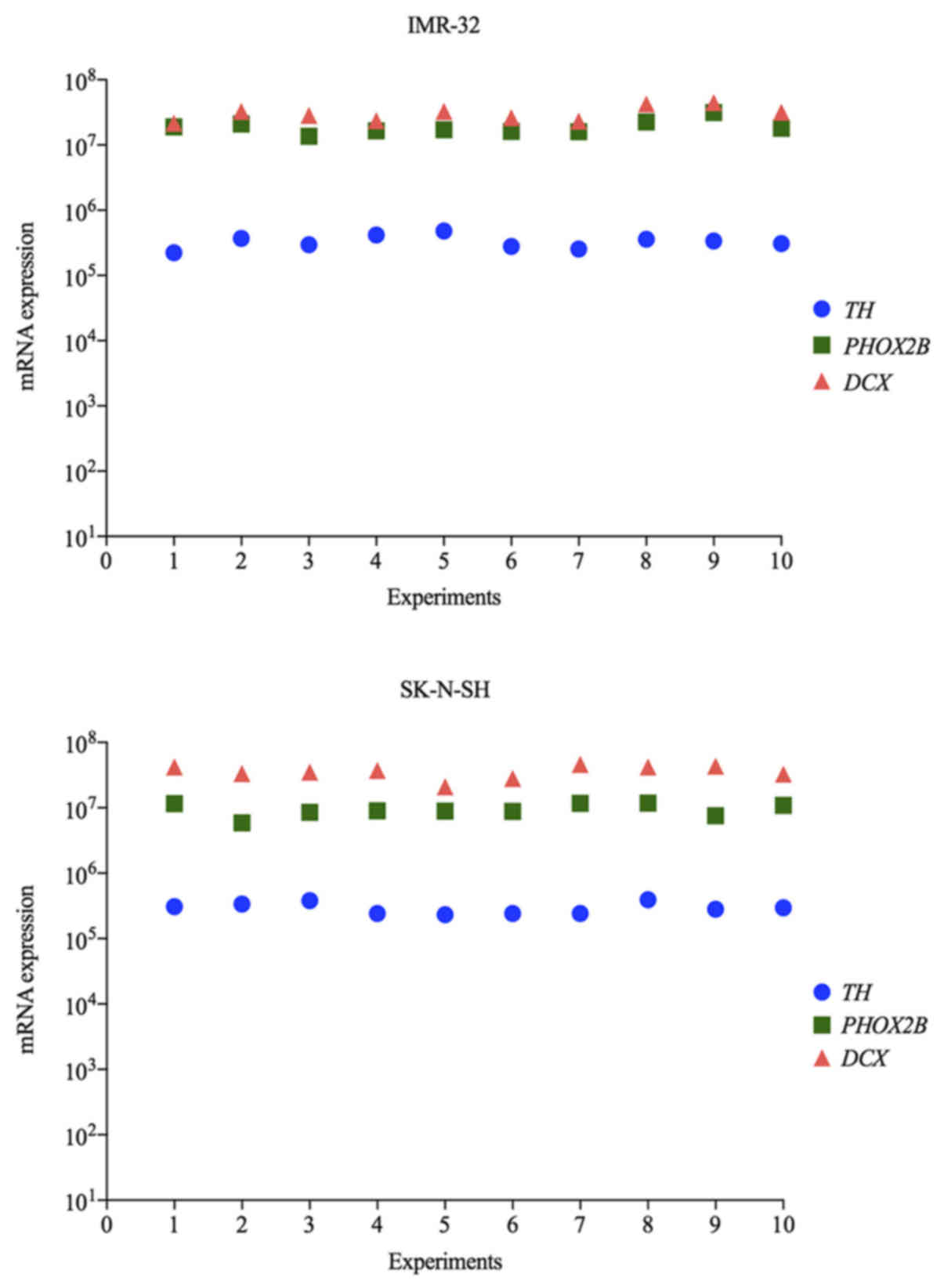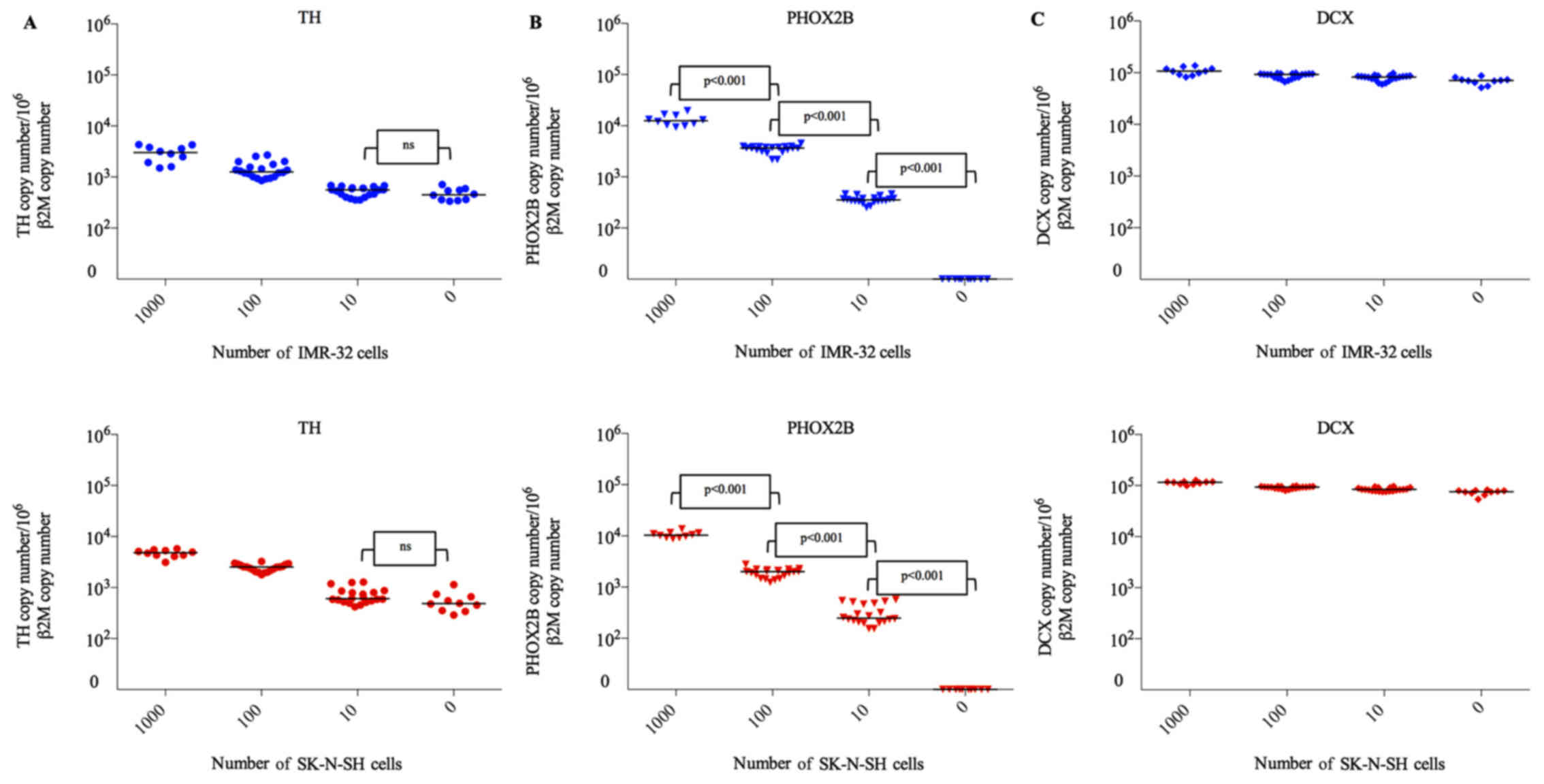|
1
|
Kaatsch P: Epidemiology of childhood
cancer. Cancer Treat Rev. 36:277–285. 2010. View Article : Google Scholar : PubMed/NCBI
|
|
2
|
Haase GM, Perez C and Atkinson JB: Current
aspects of biology, risk assessment, and treatment of
neuroblastoma. Semin Surg Oncol. 16:91–104. 1999. View Article : Google Scholar : PubMed/NCBI
|
|
3
|
Oberthuer A, Hero B, Berthold F, Juraeva
D, Faldum A, Kahlert Y, Asgharzadeh S, Seeger R, Scaruffi P, Tonini
GP, et al: Prognostic impact of gene expression-based
classification for neuroblastoma. J Clin Oncol. 28:3506–3515. 2010.
View Article : Google Scholar : PubMed/NCBI
|
|
4
|
Brougham MF and Wallace WH: Subfertility
in children and young people treated for solid and haematological
malignancies. Br J Haematol. 131:143–155. 2005.PubMed/NCBI
|
|
5
|
Lee SJ, Schover LR, Partridge AH, Patrizio
P, Wallace WH, Hagerty K, Beck LN, Brennan LV and Oktay K: American
Society of Clinical Oncology: American Society of Clinical Oncology
recommendations on fertility preservation in cancer patients. J
Clin Oncol. 24:2917–2931. 2006. View Article : Google Scholar : PubMed/NCBI
|
|
6
|
Loren AW, Mangu PB, Beck LN, Brennan L,
Magdalinski AJ, Partridge AH, Quinn G, Wallace WH and Oktay K;
American Society of Clinical Oncology, : Fertility preservation for
patients with cancer: American Society of Clinical Oncology
clinical practice guideline update. J Clin Oncol. 31:2500–2510.
2013. View Article : Google Scholar : PubMed/NCBI
|
|
7
|
Sudour-Bonnange H, Tabone MD,
Thomas-Teinturier C, Pacquement H, Oberlin O, Marec-Berard P,
Laurence V, Aubier F, Duranteau L, Bernier-Chastagner V, et al:
Fertility preservation in children and teenagers with cancer. Bull
Cancer. 100:727–735. 2013.(In French). PubMed/NCBI
|
|
8
|
Daudin M, Rives N, Walschaerts M,
Drouineaud V, Szerman E, Koscinski I, Eustache F, Saïas-Magnan J,
Papaxanthos-Roche A, Cabry-Goubet R, et al: Sperm cryopreservation
in adolescents and young adults with cancer: Results of the French
national sperm banking network (CECOS). Fertil Steril.
103:478–486.e1. 2015. View Article : Google Scholar : PubMed/NCBI
|
|
9
|
Wyns C, Curaba M, Vanabelle B, Van
Langendonckt A and Donnez J: Options for fertility preservation in
prepubertal boys. Hum Reprod Update. 16:312–328. 2010. View Article : Google Scholar : PubMed/NCBI
|
|
10
|
Rives N, Milazzo JP, Travers A, Arkoun B,
Bironneau A, Sibert L, Liard-Zmuda A, Marie-Cardine A, Schneider P,
Vannier JP and Macé B: Cryopreservation of testicular tissue in
children. Bull Acad Natl Med. 197:877–886. 2013.(In French).
PubMed/NCBI
|
|
11
|
Goossens E, Van Saen D and Tournaye H:
Spermatogonial stem cell preservation and transplantation: From
research to clinic. Hum Reprod. 28:897–907. 2013. View Article : Google Scholar : PubMed/NCBI
|
|
12
|
Shinohara T, Inoue K, Ogonuki N,
Kanatsu-Shinohara M, Miki H, Nakata K, Kurome M, Nagashima H,
Toyokuni S, Kogishi K, et al: Birth of offspring following
transplantation of cryopreserved immature testicular pieces and
in-vitro microinsemination. Hum Reprod. 17:3039–3045. 2002.
View Article : Google Scholar : PubMed/NCBI
|
|
13
|
Kanatsu-Shinohara M, Ogonuki N, Inoue K,
Ogura A, Toyokuni S and Shinohara T: Restoration of fertility in
infertile mice by transplantation of cryopreserved male germline
stem cells. Hum Reprod. 18:2660–2667. 2003. View Article : Google Scholar : PubMed/NCBI
|
|
14
|
Nakai M, Kaneko H, Somfai T, Maedomari N,
Ozawa M, Noguchi J, Ito J, Kashiwazaki N and Kikuchi K: Production
of viable piglets for the first time using sperm derived from
ectopic testicular xenografts. Reproduction. 139:331–335. 2010.
View Article : Google Scholar : PubMed/NCBI
|
|
15
|
Stukenborg JB, Schlatt S, Simoni M, Yeung
CH, Elhija MA, Luetjens CM, Huleihel M and Wistuba J: New horizons
for in vitro spermatogenesis? An update on novel three-dimensional
culture systems as tools for meiotic and post-meiotic
differentiation of testicular germ cells. Mol Hum Reprod.
15:521–529. 2009. View Article : Google Scholar : PubMed/NCBI
|
|
16
|
Reuter K, Ehmcke J, Stukenborg JB, Simoni
M, Damm OS, Redmann K, Schlatt S and Wistuba J: Reassembly of
somatic cells and testicular organogenesis in vitro. Tissue Cell.
46:86–96. 2014. View Article : Google Scholar : PubMed/NCBI
|
|
17
|
Kumari PK, Surendran N, Chellam VG, Pillai
GR and Ramachandran K: Neuroblastoma with testicular metastasis.
Review of literature and report of a case. Indian J Cancer.
31:52–55. 1994.PubMed/NCBI
|
|
18
|
Casola G, Scheible W and Leopold GR:
Neuroblastoma metastatic to the testis: ultrasonographic screening
as an aid to clinical staging. Radiology. 151:475–476. 1984.
View Article : Google Scholar : PubMed/NCBI
|
|
19
|
Simon T, Hero B and Berthold F: Testicular
and paratesticular involvement by metastatic neuroblastoma. Cancer.
88:2636–2641. 2000. View Article : Google Scholar : PubMed/NCBI
|
|
20
|
Tchirkov A, Paillard C, Halle P, Bernard
F, Bordigoni P, Vago P, Deméocq F and Kanold J: Significance of
molecular quantification of minimal residual disease in metastatic
neuroblastoma. J Hematother Stem Cell Res. 12:435–442. 2003.
View Article : Google Scholar : PubMed/NCBI
|
|
21
|
Burchill SA, Lewis IJ, Abrams KR, Riley R,
Imeson J, Pearson AD, Pinkerton R and Selby P: Circulating
neuroblastoma cells detected by reverse transcriptase polymerase
chain reaction for tyrosine hydroxylase mRNA are an independent
poor prognostic indicator in stage 4 neuroblastoma in children over
1 year. J Clin Oncol. 19:1795–1801. 2001. View Article : Google Scholar : PubMed/NCBI
|
|
22
|
Chambon F, Tchirkov A, Pereira B, Rochette
E, Deméocq F and Kanold J: Molecular assessment of minimal residual
disease in PBSC harvests provides prognostic information in
neuroblastoma. Pediatr Blood Cancer. 60:E109–E112. 2013. View Article : Google Scholar : PubMed/NCBI
|
|
23
|
Stutterheim J, Zappeij-Kannegieter L, Ora
I, van Sluis PG, Bras J, den Ouden E, Versteeg R, Caron HN, van der
Schoot CE and Tytgat GA: Stability of PCR targets for monitoring
minimal residual disease in neuroblastoma. J Mol Diagn. 14:168–175.
2012. View Article : Google Scholar : PubMed/NCBI
|
|
24
|
Viprey VF, Gregory WM, Corrias MV,
Tchirkov A, Swerts K, Vicha A, Dallorso S, Brock P, Luksch R,
Valteau-Couanet D, et al: Neuroblastoma mRNAs predict outcome in
children with stage 4 neuroblastoma: A European HR-NBL1/SIOPEN
study. J Clin Oncol. 32:1074–1083. 2014. View Article : Google Scholar : PubMed/NCBI
|
|
25
|
Pinto NR, Applebaum MA, Volchenboum SL,
Matthay KK, London WB, Ambros PF, Nakagawara A, Berthold F,
Schleiermacher G, Park JR, et al: Advances in risk classification
and treatment strategies for neuroblastoma. J Clin Oncol.
33:3008–3017. 2015. View Article : Google Scholar : PubMed/NCBI
|
|
26
|
Brünsten RL and Zimmermann JW:
Spermatogenesis following male germ-cell transplantation. Proc Natl
Acad Sci USA. 91:pp. 11298–11302. 1994; PubMed/NCBI
|
|
27
|
Baert Y, van Saen D, Haentjens P, In't
Veld P, Tournaye H and Goossens E: What is the best
cryopreservation protocol for human testicular tissue banking? Hum
Reprod. 28:1816–1826. 2013. View Article : Google Scholar : PubMed/NCBI
|
|
28
|
Yáñez Y, Hervás D, Grau E, Oltra S, Pérez
G, Palanca S, Bermúdez M, Márquez C, Cañete A and Castel V: TH and
DCX mRNAs in peripheral blood and bone marrow predict outcome in
metastatic neuroblastoma patients. J Cancer Res Clin Oncol.
142:573–580. 2016. View Article : Google Scholar : PubMed/NCBI
|
|
29
|
Kushner BH, Vogel R, Hajdu SI and Helson
L: Metastatic neuroblastoma and testicular involvement. Cancer.
56:1730–1732. 1985. View Article : Google Scholar : PubMed/NCBI
|
|
30
|
Nistal M, González-Peramato P and Paniagua
R: Secondary testicular tumors. Eur Urol. 16:185–188.
1989.PubMed/NCBI
|
|
31
|
Gilbert LC and Wachsman JT:
Characterization and partial purification of the plasminogen
activator from human neuroblastoma cell line, SK-N-SH. A comparison
with human urokinase. Biochim Biophys Acta. 704:450–460. 1982.
View Article : Google Scholar : PubMed/NCBI
|
|
32
|
Tumilowicz JJ, Nichols WW, Cholon JJ and
Greene AE: Definition of a continuous human cell line derived from
neuroblastoma. Cancer Res. 30:2110–2118. 1970.PubMed/NCBI
|
|
33
|
Viprey VF, Corrias MV, Kagedal B, Oltra S,
Swerts K, Vicha A, Ladenstein R and Burchill SA: Standardisation of
operating procedures for the detection of minimal disease by
QRT-PCR in children with neuroblastoma: Quality assurance on behalf
of SIOPEN-R-NET. Eur J Cancer. 43:341–350. 2007. View Article : Google Scholar : PubMed/NCBI
|
|
34
|
Viprey VF, Lastowska MA, Corrias MV,
Swerts K, Jackson MS and Burchill SA: Minimal disease monitoring by
QRT-PCR: Guidelines for identification and systematic validation of
molecular markers prior to evaluation in prospective clinical
trials. J Pathol. 216:245–252. 2008. View Article : Google Scholar : PubMed/NCBI
|
|
35
|
Davidoff MS, Ungefroren H, Middendorff R,
Koeva Y, Bakalska M, Atanassova N, Holstein AF, Jezek D, Pusch W
and Müller D: Catecholamine-synthesizing enzymes in the adult and
prenatal human testis. Histochem Cell Biol. 124:313–323. 2005.
View Article : Google Scholar : PubMed/NCBI
|
|
36
|
Seil FJ, Johnson ML, Nishi R and Nilaver
G: Tyrosine hydroxylase expression in non-catecholaminergic cells
in cerebellar cultures. Brain Res. 569:164–168. 1992. View Article : Google Scholar : PubMed/NCBI
|
|
37
|
Schulze W, Davidoff MS and Holstein AF:
Are Leydig cells of neural origin? Substance P-like
immunoreactivity in human testicular tissue. Acta Endocrinol
(Copenh). 115:373–377. 1987.PubMed/NCBI
|
|
38
|
Oltra S, Martinez F, Orellana C, Grau E,
Fernandez JM, Cañete A and Castel V: The doublecortin gene, a new
molecular marker to detect minimal residual disease in
neuroblastoma. Diagn Mol Pathol. 14:53–57. 2005. View Article : Google Scholar : PubMed/NCBI
|
|
39
|
Zeng L, Gu S, Li Y, Zhao E, Xu J, Ye X, Wu
Q, Wang L, Xie Y and Mao Y: Identification of a novel human
doublecortin-domain-containing gene (DCDC1) expressed mainly in
testis. J Hum Genet. 48:393–396. 2003. View Article : Google Scholar : PubMed/NCBI
|
|
40
|
Stutterheim J, Gerritsen A,
Zappeij-Kannegieter L, Kleijn I, Dee R, Hooft L, van Noesel MM,
Bierings M, Berthold F, Versteeg R, et al: PHOX2B is a novel and
specific marker for minimal residual disease testing in
neuroblastoma. J Clin Oncol. 26:5443–5449. 2008. View Article : Google Scholar : PubMed/NCBI
|
|
41
|
Corrias MV, Haupt R, Carlini B, Cappelli
E, Giardino S, Tripodi G, Tonini GP, Garaventa A, Pistoia V and
Pistorio A: Multiple target molecular monitoring of bone marrow and
peripheral blood samples from patients with localized neuroblastoma
and healthy donors. Pediatr Blood Cancer. 58:43–49. 2012.
View Article : Google Scholar : PubMed/NCBI
|

















